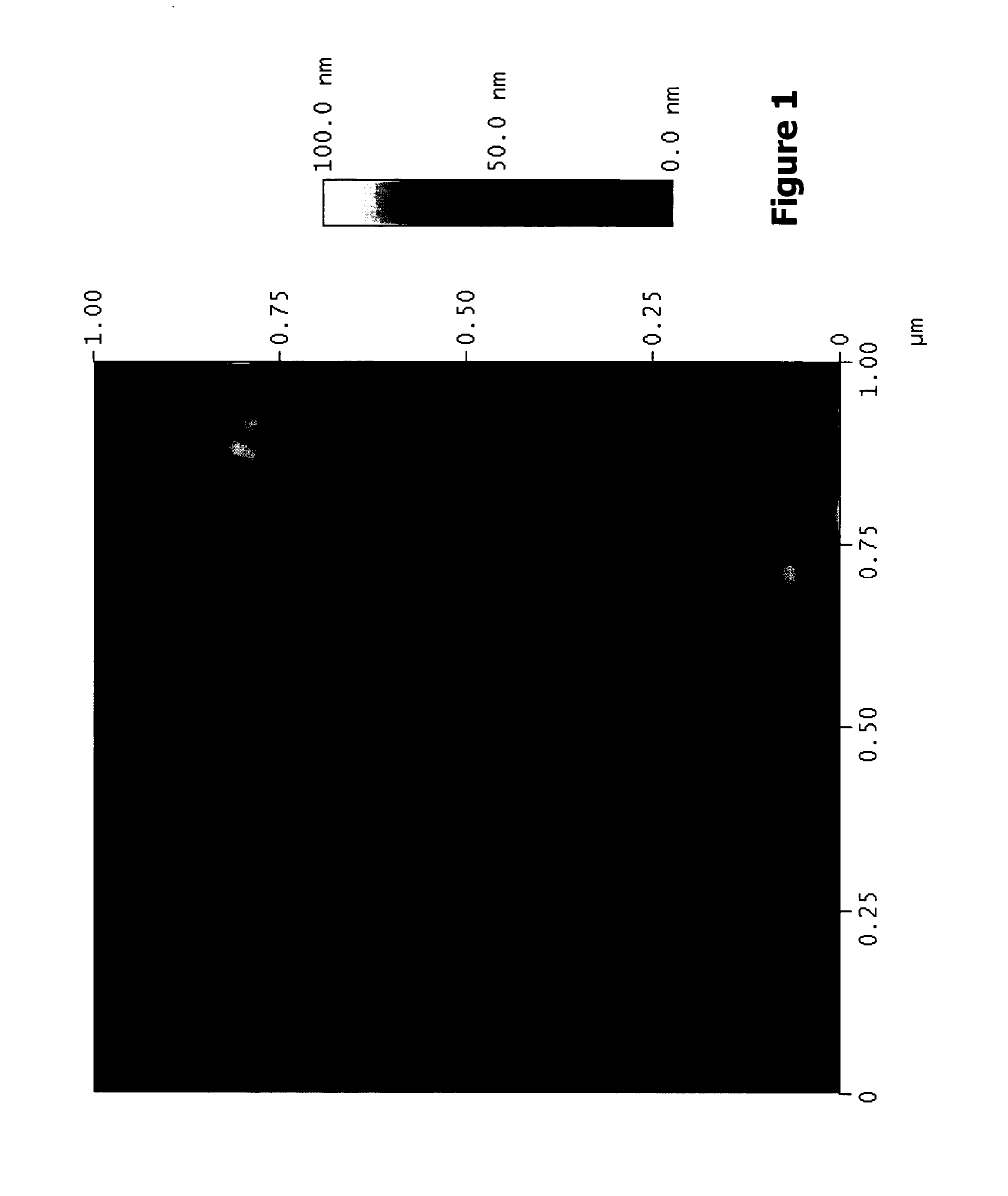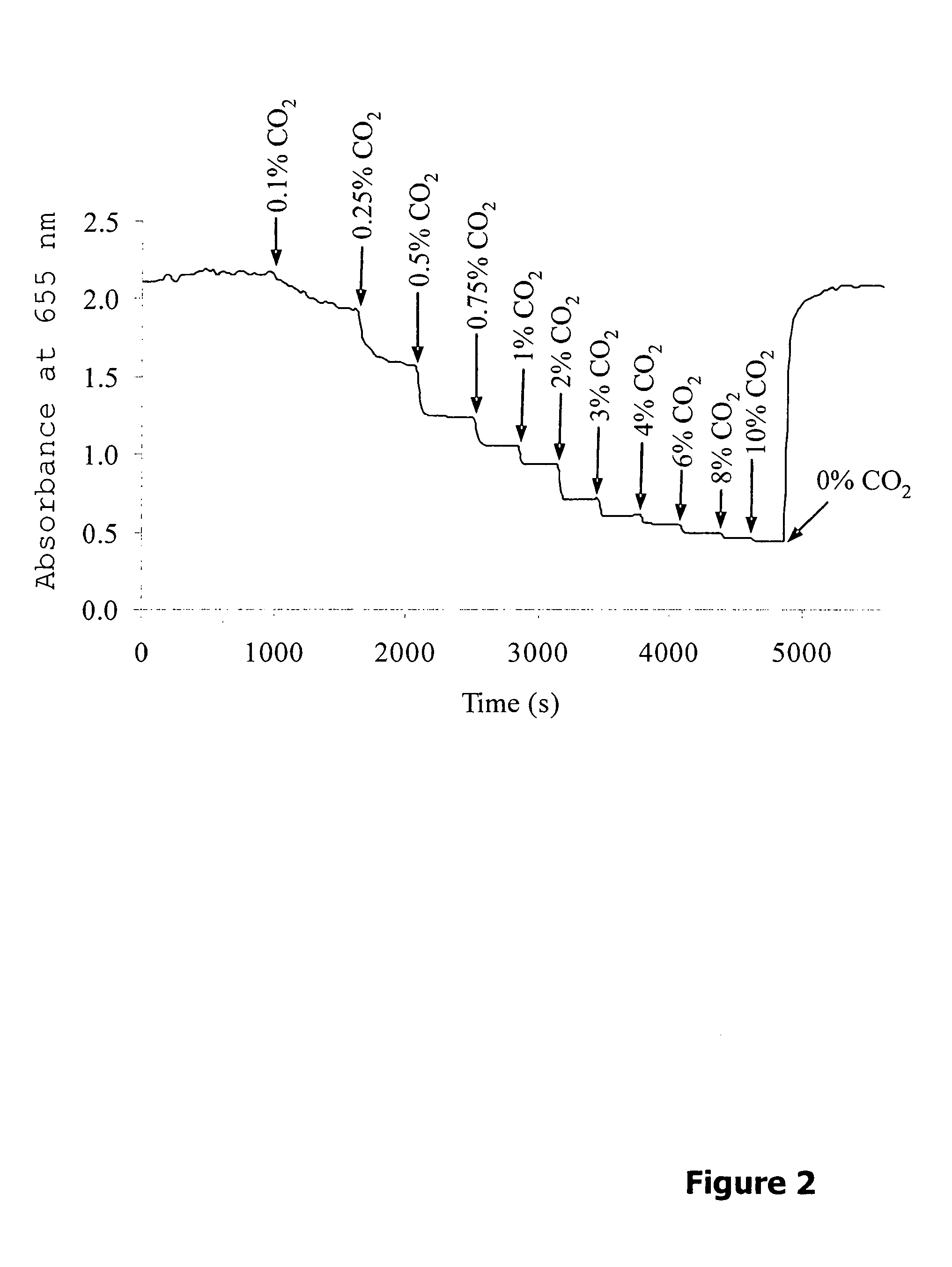Metal oxide membrane with a gas-selective compound
a technology of metal oxide membrane and selective compound, which is applied in the field of metal oxide membrane with selective compound, can solve the problems of limited use and inability to welcome in vivo investigations, and achieve the effects of increasing reaction and response time, increasing photostability and stability, and excellent access to selective compound
- Summary
- Abstract
- Description
- Claims
- Application Information
AI Technical Summary
Benefits of technology
Problems solved by technology
Method used
Image
Examples
example 1
Aluminum Oxide / Hydroxide for Developing Oxygen Sensors
a) Preparation of Aluminum Oxide / Hydroxide
[0081]50 g of the aluminum oxide / hydroxide DISPERAL 100 / 2 (available from SASOL GmbH, Hamburg, Germany) of formula AlOOH·n H2O (77.2% Al2O3) were dispersed for 15 minutes un vigorous mechanical stirring at a temperature of 20° C. in 948 g of doubly distilled water. Afterwards temperature was increased to 90° C. and stirring was continued for 15 minutes at this temperature. The solid was filtered, washed three times with doubly distilled water and dried to 110° C.
b) Preparation of a Coating Solution
[0082]8 g of the solid from example 1 a) were added to a mixtures of 63 g of doubly distilled water and 0.96 g of concentrated acetic acid (80%). The resulting dispersion was exposed for 3 minutes at 40° C. to ultrasound. Afterwards, 8 g of a solution of polyvinyl alcohol (10% by weight, hydrolysis degree 98-99%, Molecular weight 85,000 to 146,000) (available from ALDRICH Chemie, Buchs, Switzerl...
example 2
Aluminum Oxide / Hydroxide for Developing CO2 Sensors
[0089]Using the same membrane as described in Example 1 a) to c) other CO2 sensible mixture was tested (in place of Ruthenium and Iridium complexes).
a) Deposition of the Gas Sensory Compounds
[0090]10−4 to 10−3 mmol of dye (α-Naphtholphthalein) and 10−4 to 10−3 mmol (200 μL) of tetraoctylammonium hydroxyl were dissolved in 400 μL of methanol. 0.2 to 0.5 mL of the solution was transferred onto the mesoporous membrane with a micropipette. The resulting gas-selective membrane was placed in ambient air for drying.
[0091]Surprisingly, the sequence in which the compounds are added to the membrane is relevant. Opposite to other media, the spin coating technique cannot be used to transfer the gas-selective compounds onto the rotating membrane. The two compounds which have to be incorporated into the membrane have to be dropped onto the membrane in separate solutions. When both α-Napththolphthalein and tetraoctylammonium hydroxide are solved i...
example 3
Aluminum Oxide / Hydroxide for Developing NOx Sensors
[0094]Using the same membrane as described in Example 1 a) to c), a membrane cocktail as used for NO2-selective sensors (Tomas Nezel (2002) Ph. D. thesis Nr. 14602, Swiss Federal Inst. of Technology (ETH Zürich, Switzerland)) was tested.
a) Deposition of the Gas Sensory Compounds
[0095]0.1 to 1.0 mg of dye (Iron-Phthalocyanine) was dissolved in 0.6 mL of THF using an additive to solubilize the dye. A mesoporous membrane was placed in a spin-coating device in THF-saturated atmosphere. 0.1 to 0.4 mL of solution was transferred onto the rotating membrane with a syringe. The resulting gas-selective mesoporous membrane was placed in ambient air for drying.
b) Evaluation for NO2 Sensors
[0096]To evaluate the applicability of our invention to the development of a NO2-sensor, the selective gas membrane described in Example 3 a) was fixed into a flow-cell and exposed to different concentrations of NO2 in synthetic air while the absorbance was me...
PUM
| Property | Measurement | Unit |
|---|---|---|
| Length | aaaaa | aaaaa |
| Pore size | aaaaa | aaaaa |
| Pore size | aaaaa | aaaaa |
Abstract
Description
Claims
Application Information
 Login to View More
Login to View More - R&D
- Intellectual Property
- Life Sciences
- Materials
- Tech Scout
- Unparalleled Data Quality
- Higher Quality Content
- 60% Fewer Hallucinations
Browse by: Latest US Patents, China's latest patents, Technical Efficacy Thesaurus, Application Domain, Technology Topic, Popular Technical Reports.
© 2025 PatSnap. All rights reserved.Legal|Privacy policy|Modern Slavery Act Transparency Statement|Sitemap|About US| Contact US: help@patsnap.com



